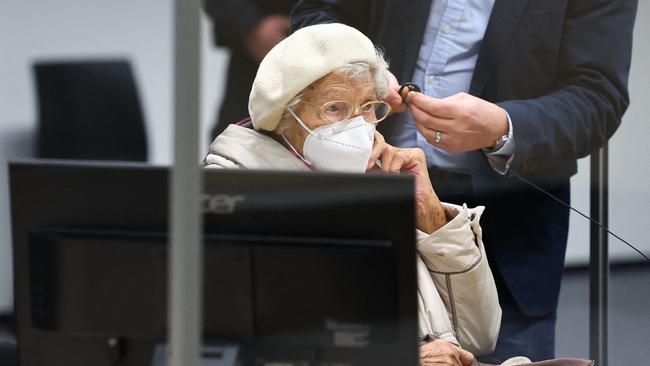Irmgard Furchner: Holocaust killer aged 96 fled nursing home to try to avoid justice
Irmgard Furchner, then in her mid-90s and once secretary to the commandant of the Stutthof concentration camp, was convicted of being an accessory to the murder of 10,000 people.

As nonagenarian Irmgard Furchner was wheeled into court in October 2021, her face was hidden behind a printed silk scarf, sunglasses and a medical mask.
She was one of the last people to face charges in relation to the Holocaust; in her case, complicity in the murders almost 80 years earlier of more than 10,000 prisoners at Poland’s Stutthof concentration camp.
Stutthof opened in September 1939, two days after the outbreak of war – the first Nazi concentration camp outside Germany and the last to be liberated by the Allies in 1945. An estimated 110,000 prisoners were transported there. More than half were murdered, including 28,000 Jews.
In June 1943, shortly after her 18th birthday, Furchner began working as a stenographer and secretary to Paul-Werner Hoppe, the camp commandant. After the war she kept a low profile, but the conviction in 2011 of John Demjanjuk, a former guard at Sobibor camp, established that anyone working at such a camp could be tried as an accessory to murder.
In February 2021 a German public prosecutor filed charges against Furchner. The trial was held in a juvenile court because she had been 18 at the time of the offences.
Furchner wrote to the judge saying that she did not wish to appear, insisting her trial was “degrading” and she wanted to “spare myself these embarrassments and not to expose myself to the mockery of humankind”.
When her request was denied she absconded from her retirement home at Quickborn, near Hamburg, taking a taxi to a train station, but she was quickly detained. Thereafter she wore an electronic ankle tag.
When her trial finally got under way, on October 19, 2021, the court was told she had full knowledge of everything that had happened at Stutthof “down to the last detail”.
The prosecution said she was responsible for ensuring “the smooth functioning of the camp”, adding that it was impossible she did not know about the killings there because her office overlooked the camp.
Furchner typed out deportation and execution orders, and dealt with reports including how much human hair had been harvested from prisoners. Each day she would have walked past the gas chamber, the crematorium and the gallows and been aware of “the omnipresent, daily inhumane treatment of the detainees … both acoustically and visually”.
Her defence did not deny the atrocities but said she had been unaware of them. She knew that executions were taking place, but believed they were punishments for specific crimes. The accusations that she heard shots or could smell the burning of bodies in the forest were assumptions.
The court case involved harrowing testimony from survivors. Risa Silbert, 93, told how cannibalism was common among starving prisoners. “People were hungry and they cut up the corpses and they wanted to take out the liver,” she said. Others described guards killing prisoners by setting dogs on them and sadistic “torture shows”, including a son being forced to beat his father to death in front of other inmates.
Asia Shindelman was 15, three years younger than Furchner, when she was taken to Stutthof. She saw her grandmother being led off to be murdered, prisoners thrown on electric fences and men fed “like meat” to dogs.
“It’s not possible for someone to say they did not know what was going on all around them. We did not look like people; we looked like skeletons,” said Shindelman, one of the few Lithuanian Jews to survive.
Manfred Goldberg, who had been forced to work as a slave labourer at Stutthof and later settled in London, described how the Germans erected an enormous gallows with eight nooses, “then one by one we had to watch these innocent men being hanged”.
The court was also told how SS guards in white medical uniforms pretended to be doctors measuring prisoners’ heights. Those heights were then used as the setting for a “neck shot” device in which about 30 prisoners were shot in the neck during a two-hour period. Others were gassed with Zyklon B.
Furchner, named the “secretary of evil”, remained quiet throughout her trial, only breaking her silence at the end with a qualified statement. “I am sorry for what happened,” she said.
She was convicted of aiding and abetting the murder of 10,505 people, and aiding and abetting the attempted murder of five more. She was given a two-year suspended sentence. Goldberg, then 92, said: “If a shoplifter is sentenced to two years, how can it be that someone convicted for complicity in 10,000 murders is given the same sentence?”
The Times







To join the conversation, please log in. Don't have an account? Register
Join the conversation, you are commenting as Logout